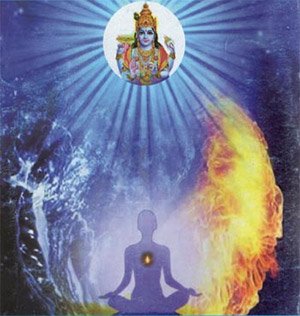Siddhanta Sangraha of Sri Sailacharya
by E. Sowmya Narayanan | 2008 | 30,562 words
Siddhanta Sangraha Chapter 18 (English translation), entitled “the supreme brahman” as included in the critical edition and study. The Siddhanta Samgraha is a Sanskrit philosophical text dealing with Vishishtadvaita in five hundred Sanskrit verses. It was written by Shri Shailacarya (18th century) and closely follows the philosophy of Vedanta Deshika (13th century).
Chapter 18 - The Supreme Brahman
170. The tattva jñāna without the teachings of acāryas will not serve the purpose. It should be understood by the great scholars from the work, Śrīmad Rahasyatrayasāra of Śrī Vedānta Deśika.[1] The nature of Brahman is that, it has five essential characteristics namely, satyatva, jñānatva, anantatva, ānandatva and heyapratyanīkatva which constitute its essential nature.
171. This aspect is technically known as svarūpa nirūpaka dharma, which means that the features that go to establish the true nature of Brahman. The causality of the Brahman is not an essential character of Brahman.
172. The causality is only an adjectival aspect of Brahman when it is associated with sentient and insentient entities in its subtle state. This is known as nirūpaka svarūpa viśeṣaṇa which means the qualities that are present in an already proved existent entity.
Footnotes and references:
[1]:
See Rahasya Traya Sāra Guruparamparasara, p.2
Conclusion:
 This concludes The Supreme Brahman according to Vishishtadvaita philosophy explained by Shri Shailacarya. This book follows the model of Vedanta Deshika although the Vishishta Advaita school was originally expounded by Shri Ramanuja. Vishishta-Advaita is one of the various sub-schools of Vedanta which itself represents one of the six orthodox schools of Hindu Philosophy. They highlight the importance of the Upanishads, the Bhagavad Gita and the Brahma Sutras.
This concludes The Supreme Brahman according to Vishishtadvaita philosophy explained by Shri Shailacarya. This book follows the model of Vedanta Deshika although the Vishishta Advaita school was originally expounded by Shri Ramanuja. Vishishta-Advaita is one of the various sub-schools of Vedanta which itself represents one of the six orthodox schools of Hindu Philosophy. They highlight the importance of the Upanishads, the Bhagavad Gita and the Brahma Sutras.
